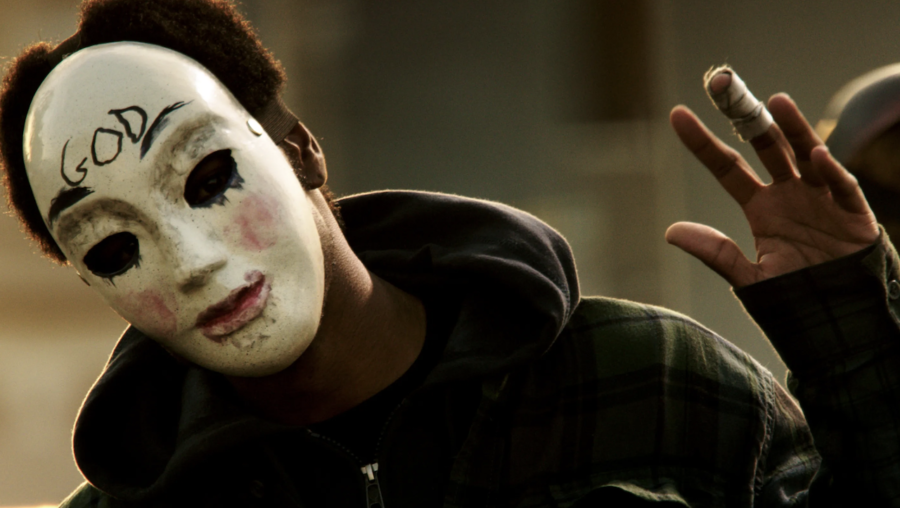The Purge: Anarchy Movie Review
Is The Purge: Anarchy worth the watch?

Let’s be true to one another. The Purge was one of the worst horrors/thrillers of the last few years, taking a potentially meaningful plot and shitting on it with terrible characters and awful decision-making. Director James DeMonaco’s actual direction was probably the fourth thing anyone thought about after watching it. Thankfully, The Purge: Anarchy is in almost every way the film that its predecessor was meant to be. Unfortunately, that still equals “Frank Grillo in an okay slasher movie.”
It is not that The Purge: Anarchy is a slasher movie, but not in the singular sense. This is a slasherssss movie, where murderers run amok in Los Angeles because it is their Founding Fathers-given right!
The Purge: Anarchy is sometimes surprising where it chooses to go with its subject matter, but only The Purge part of its subject matter. For two films now, DeMonaco has teased horror fans with a truly great scenario—the U.S. allows its more depraved citizens the right to go nuts for twelve hours a year, with no consequences. And for two films, he has delivered stale genre movies rife with stereotypes. But at least this one has Frank Grillo front and center.
Here’s how the The Purge: Anarchy stories break down, before they’re unfortunately thrown together by way of “how the hell did this happen in a city as big as Los Angeles?” coincidences.
Frank Grillo plays an all-but-nameless man who is seeking revenge against the man who killed his son. (Which, by the way, is all an action hero needs for exposition.)
And then we have Eva (Carman Ejogo) and Cali (Zoë Soul), a mother and daughter who are down on their luck, with an ill elder (John Beasley) in the house whose medicine keeps finances tight.
Finally, there are Shane (Zach Gilford) and Liz (Kiele Sanchez), a couple too fucking stupid to realize that they shouldn’t be doing any cross-California traveling on the most dangerous night of the year.
Suffice it to say, Grillo is all set to get his murder on when both of the other parties have their lives completely ruined by people aiming to Purge. (Or, as that one guy put it, “PURRRRRGE!!!”)
In The Purge: Anarchy, the five of them end up together after a chance encounter with a big-ass truck full of masked murderers. This isn’t the group of masked (and face-painted) murderers that torment Shane and Liz, though, but those guys are also around every corner, no matter where in L.A. people the heroes go.
And it’s there where the critic in me and the “guy just trying to get his alcoholic drink on” in me came to a fork in the road and called it quits with one another. The Purge: Anarchy is not a good movie, but it is a good movie to see in theaters because the admittedly generic action, horror, and tension are unrelenting from the first frame.
Does it all make sense in some meaningful and tangible way? Not in the slightest. At one point, there is just a random person walking across a building top, preaching through a megaphone, and that person never shows up again.
Still, I was hooked for the final The Purge: Anarchy two acts—if one can call people running around trying not to get slaughtered “acts”—and found myself hooting and hollering at things along with the rest of the audience.
As morally repugnant as it is to laugh at Frank Grillo blowing people away with bizarre precision, it feels right. The Wire‘s Michael K. Williams plays an anti-establishment, anti-Purge talking head who rails against the powers that be, and he’s definitely the highlight of the entire feature, appearing both as an Internet Black Panther and as a front-line Spike Lee, sporting round-rimmed glasses and a beret, not to mention a graying beard.
Unlike the first film, The Purge: Anarchy is a movie about citizens branching out and stepping up against the purging public, fighting for their lives. Had the movie capitalized on its “rich vs. poor” class dilemma, it might have been a cautionary tale for the future, though the evil Founding Fathers brigade will almost certainly never exist.
But it doesn’t, and even though the class problems present an interesting climax, it’s better suited for a video game. (Or even DLC content for a better video game.)
The Purge: Anarchy, arguably more than any other movie, proves that Frank Grillo needs his own franchise, but one with a director skilled at shooting action scenes without just throw the camera all over the place. DeMonaco certainly ups his game here visually, but it still falls as flat as the story when compared to better movies.
Go for the danger-everywhere experience, and you probably won’t be disappointed. Go for the story, and you’ll find yourself wishing you had a level-5 explosive.
Now, can we make the next Purge movie about the hospitals and cops who have to deal with the plethora of injuries and deaths created by Purge night?












